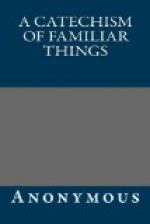Implied, signified, denoted.
Posterity, succeeding generations, descendants.
Immortalize,
to render immortal,—which means never-dying;
to perpetuate the memory
of anything.
What is a Pyramid?
A solid, massive edifice, rising from a square, triangular, or other base, gradually diminishing in size till it ends in a point at the top. Like the obelisk, pyramids were sometimes erected to preserve the memory of singular events, or to transmit to future ages the glory and magnificence of princes; but oftener as funeral monuments and receptacles for the dead, particularly kings.
Triangular, three-sided, having three angles.
Diminishing, growing smaller.
Receptacle, the place in which a thing is deposited.
Is it known who were the erectors of these Buildings?
No; it is a curious fact that the Egyptian pyramids, so celebrated for their size and great antiquity, should have the time of their erection and the names of their founders wrapt in such complete mystery. All the different authors who have written concerning them, disagree in their accounts of those who built them, and nothing certain is known of their history.
Founder, one who establishes or erects.
Mystery, profound secresy.
What other nations excelled in the art of Building?
The Greeks and Romans, from whom we derive it, also greatly excelled in this art. Grecian architecture was in its highest glory under Pericles. Among the Romans, it arrived at its greatest perfection under the Emperor Augustus. The five orders of ornamental architecture invented by the ancients, at different times, and on different occasions, are of Grecian and Italian origin. They are the Tuscan, the Doric, the Ionic, the Corinthian, and the Composite; each possessing its peculiar form and beauty, and found in all the principal buildings of the Christian world.
Christian, professing
the religion of Christ; the term is
applied to those who
believe our Lord Jesus Christ to be the
only true God and Saviour
of the world.
Who was Pericles?
A celebrated Athenian statesman, orator, and general, who gained several victories over the Lacedemonians and other enemies of his country.
Are all the species of ornamental building confined to those nations already mentioned?
By no means; besides the Grecian and Roman orders, other civilized nations possess their separate styles; as the Hindoos, Chinese, Moors, &c.; and nothing can be more grand, harmonious, and picturesque, than each of these in the beautiful specimens which are to be seen in their several countries. The Saxons, also, had a simple style of architecture, distinguished by semi-circular arches, and massive plain columns; the Normans, too, invented a beautiful kind called the Gothic, distinguished by its lightness and the number of its ornaments, and by its pointed arches and pillars carved to imitate several combined together; the Gothic style is found in many old cathedrals.




